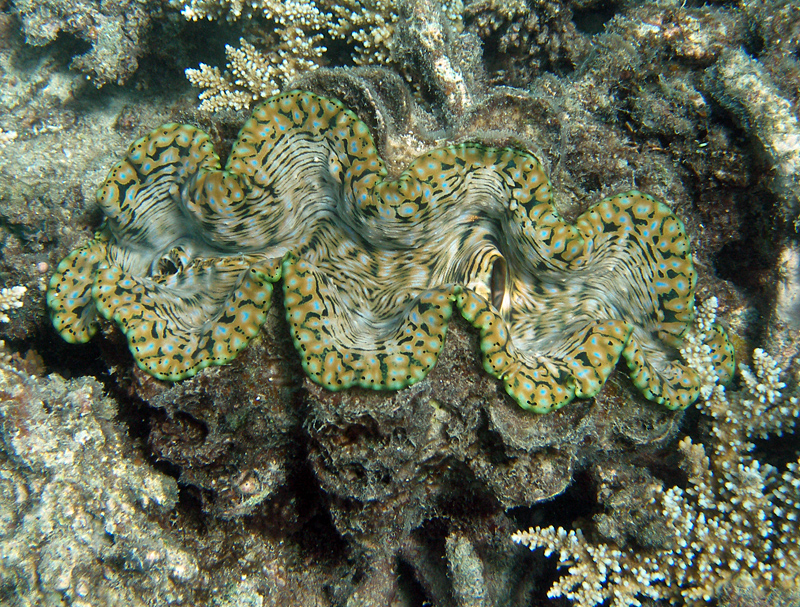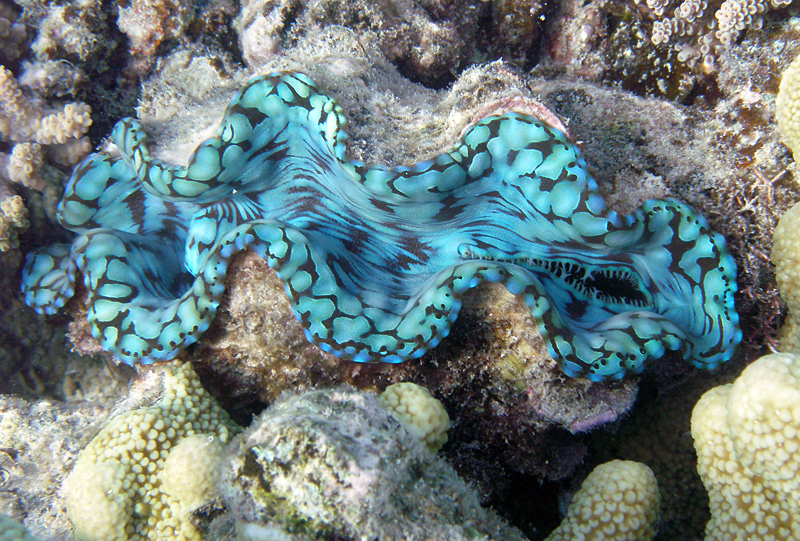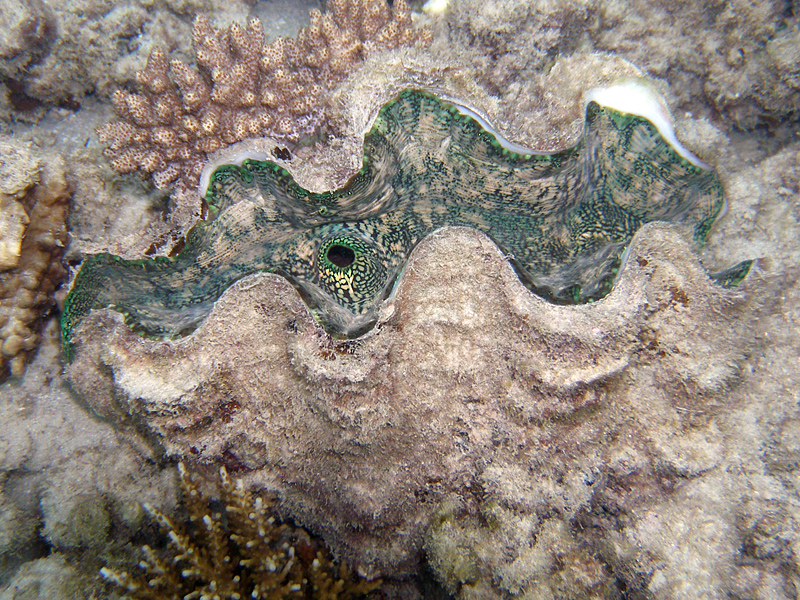
©Andy Lewis: An adult Tridacna squamosa at Mermaid Cove, showing the symmetrical shell valves and widely-spaced external scutes

©Andy Lewis: Colour variation in Tridacna squamosa from the reef flat between Palfrey & South Island
Colours
Distinguishing features
The third largest species of Giant Clam, this species has symmetrical shell valves and large widely spaced scutes. The animal is attached to the benthos by the byssal threads when small, however it does not embed in the substratum like T. crocea and T. maxima. Mantle colour is highly variable, with blotchy blue, green, and brown patterns found within local populations at Lizard Island, and the mantle extends over the edge of the shell when fully extended. Distinguish from other species of Tridacna by the symmetrical shell and widely-spaced scutes.
Size
- Up to 40 cm (Length of specimen)
Synonyms
Distribution
Distribution and habitat preferences
Found in most habitats, but most abundant in sheltered microhabitats near exposed reef front areas (eg. deeper gullies behind reef crests). Not generally seen below about 5-6m.
Found in most shallow habitats around Lizard Island, and extends down to 8-10m. T. squamosa is the rarest species of Tridacnid clam at this location.
Behaviour
Like other Tridacnid clams, this species is a hermaphrodite, with the male testes forming first at about 3 years of age, followed by the female ovaries a year or so later. Tridacnid clams spawn in the warm summer months between October and February, usually during neap tides when water movement is minimal. This allows enough time for adequate mixing of the gametes. Spermatozoa are usually released first, with eggs only released if the animal detects the presence of sperm from a conspecific clam in the water column. Hence, reproduction is most successful when the animals are located in natural clusters. Eggs are only 100µ���������������������m (1/10th of a mm) in diameter, and several million are released by each clam during a spawning event. Fertilisation is external, and a trochophore larvae hatches after about 12 hours. A bivalved veliger larvae develops after 48 hours, with a shell length of 160µ���������������������m. This stage feeds on plankton and continues to swim in the water column, although it periodically ventures down to assess the conditions on the benthos. The veliger larvae settle permanently to the substratum at about 9 days of age and about 200µ����������������������������m, and the juvenile clams may reach 20-40mm shell length after their first year. Growth accelerates after this point, however mortality in the first few years is very high, with predation by fishes being a major factor.
Tridacnid clams obtain over 95% of their food requirements from the sugars produced by the symbiotic dinoflagellate algae (zooxanthellae) that inhabit the outer mantle tissue. Juvenile clams acquire the zooxanthellae directly from the water column at the time of settlement, and the algae live in tubules that are tertiary extensions of the gut and extend throughout the mantle tissue. Research in the Red Sea shows that T. squamosa is more heterotrophic than T. maxima. Like hard corals, Tridacnid clams may bleach and lose most of their zooxanthellae after high temperature stress.
Web resources
References
- Braley, R.D. (1985). Serotonin-induced spawning in giant clams (Bivalvia:Tridacnidae), Aquaculture, 47: 321-325. LIRS catalog number 179.
- Goggin, C.L. and R.J.G. Lester (1987). Occurrence of Perkinsus species (Protozoa, Apicomplexa) in bivalves from the Great Barrier Reef, Diseases of Aquatic Organisms, 3: 113-117. LIRS catalog number 237.
- Griffiths, D.J., H. Windsor and T. Luong-Van (1992). Iridophores in the mantle of Giant Clams, Australian Journal of Zoology, 40: 319.
- View all references













